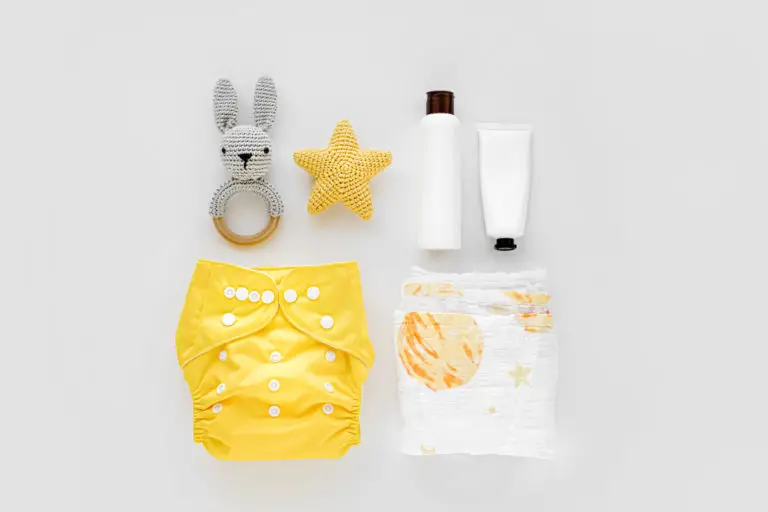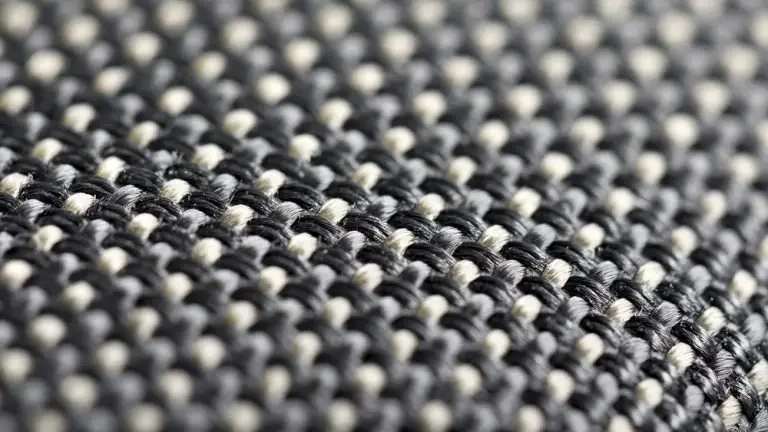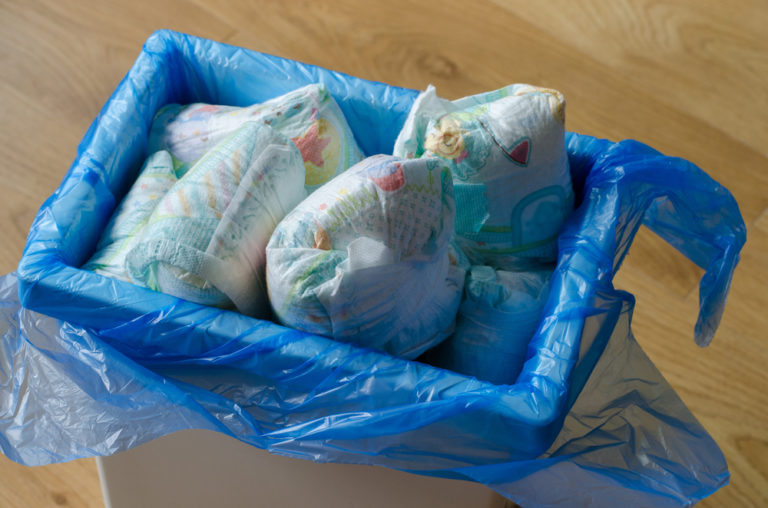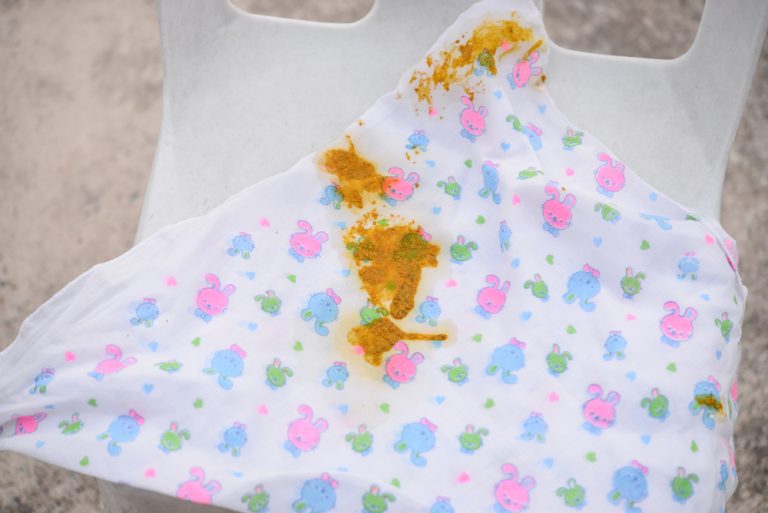What Are Diapers Made Of? (Layer by Layer Overview)
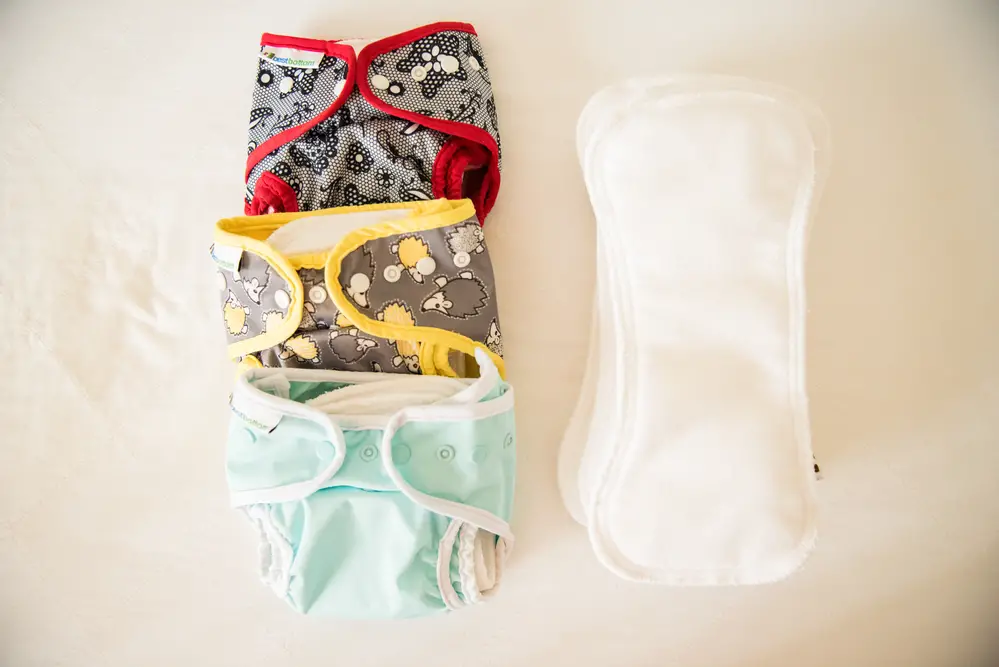
Disposable diapers are made of a polypropylene top sheet, polyethylene backsheet, and an SAP/cellulose absorbent core. These components can be synthetic or plant-based. They also contain elastic and a polypropylene fastening system.
What Are Diapers Made Of?
Diaper parts are made from various materials, but the most common are polyester nonwoven, SAP/wood fluff, and polyethylene/polypropylene.
Topsheet
Polypropylene is a common diaper material and is the top sheet that touches your baby’s skin. It allows liquid to pass through quickly into the absorbent core. It is made from hydrophilic and hydrophobic nonwoven sheets.
The hydrophobic parts are the leak guards at the crotch and leg cuffs. The hydrophilic components make contact with the skin and transfer the urine to the core (1). Polypropylene in diapers is made from petroleum-based plastic but is considered safe for use (3).
Polypropylene is made from plastic resins that are mechanically, chemically, or thermally bonded to create non-woven sheets (4). These are softer but, unfortunately, are not biodegradable.
Absorbent Core
The absorbent core improves the function of disposable diapers. It absorbs and locks in liquid, keeping your baby dry. Typical core materials are SAP and cellulose wood pulp fluff (2). The diaper SAP is usually sodium polyacrylate that forms a diaper gel in the core when wet (1).
The SAP increases the absorption capacity, and the cellulose fibers transfer moisture quickly. SAP is considered safe to use in diapers (17). Wood fluff is safe if it hasn’t been bleached with chlorine. SAP allows for a thinner diaper and reduces diaper rash because it locks in moisture (11). Unfortunately, SAP is not biodegradable.
Backsheet Outer Layer
The backsheet is one of the important diaper layers that make the diaper effective. It is the outer layer that prevents liquid from leaking out of the diaper and transferring to clothes. It is usually made from a waterproof polyethylene film (1). This hydrophobic nonwoven film is considered safe for diaper use.
It is breathable and keeps your baby’s skin dry. Some diapers have a backsheet made from bioplastic polyethylene or plant-based polypropylene. This polymer is often derived from corn or sugar cane. Unlike synthetic polyethylene, plant-based polymers can biodegrade (18).
Closing System
The parts of the closing system are important disposable diaper properties as they create the shape of the diaper and ensure a good fit. The closing system includes waist fasteners and leg elastics.
Leg elastics cinch the leg cuffs to create a snug, leak-proof fit. The eartabs and fasteners at the waist can be sticky polypropylene lateral tape closed onto a polypropylene frontal tape. It can also be a hook and loop tape that offers good mechanical grip.
Hook and loop closures are adjustable without tearing the diaper. This allows you to create a snug and comfortable fit on your baby. These are baby-safe and not biodegradable (2).
Leg Cuffs
Parts of a diaper that are essential are leg cuffs. They are made from polyurethane/polyester foam elastics and synthetic rubber or lycra/spandex (2). Polyurethane and spandex are safe in diapers and they are also encased by nonwoven material and don’t touch your baby’s skin.
These leg cuffs allow the diaper to fit snugly around your baby’s thighs and prevent leaks. They are soft and allow for flexible movement. Leg cuffs are not biodegradable unless made from plant-based materials rather than synthetics.
Disposable Diaper Filling
Different diaper subscription brands use different diaper fillings but the most common are SAP, cellulose, polypropylene, and polyethylene. Not all brands use these diaper ingredients and some are natural and plant-based.
Polyethylene film
Diapers have a polyethylene film on the backsheet that keeps moisture inside the diaper while allowing airflow. It is not biodegradable and is made from petroleum-based plastics. Polyethylene used in diapers undergoes rigorous testing and safety evaluations (6). Some diapers make the backsheet from bioplastics from renewable and natural sources.
Polypropylene Nonwoven
Polypropylene nonwoven is used to transfer liquids to absorbent materials in diapers. It offers good absorption and is soft against the skin and won’t irritate it (7). It is made from biologically inert polymers that are safe in diapers (9). Polypropylene is lightweight and flexible (8). It is not biodegradable.
Cellulose/Pulp
Cellulose is wood pulp fluff found in the absorbent diaper core. It has a good absorbing capacity because of the high ratios of fibers to weight. This allows it to move liquid quickly and lock it in place (13). This pulp keeps your baby dry for longer. It is safe and biodegradable when not bleached (2).
Super Absorbent Polymer (SAP)
SAP is one of the ingredients in disposable diapers that make them so effective. It is fine granules that absorb moisture. These diaper beads increase the retention capacity and sodium polyacrylate is the common diaper filling compound. SAP is considered safe for use in diapers but is not biodegradable (2).
Bromophenol blue
Bromophenol blue is a pH indicator used as a wetness indicator in diapers. Diaper chemicals like bromophenol blue are common. It is yellow when dry but turns blue when wet with slightly alkaline pH like urine (1). It is not considered carcinogenic but can cause skin irritation if absorbed (16). The wetness indicator is placed inside the diaper layers and does not touch your baby’s skin.
Dyes
Dyes are not biodegradable unless made from plant-based sources. They are used in the wetness indicator and the prints on the diaper. Most dyes used in diapers are non-sensitizing pigments that undergo safety tests. Diapers do not usually contain dispersed dyes which are dangerous (17). Babies with sensitive skin might have an allergenic reaction to dyes.
Dioxins
Dioxins are introduced through chlorine in diapers when the wood pulp is bleached. Dioxins are not safe diaper raw materials. They are associated with an increased risk of cancer, hormone disruption, and developmental problems (10). They are thought to improve the absorbency and cushioning of the cellulose fibers. Dioxins are not biodegradable and are harmful to waterways.
Phthalates
Phthalates are chemicals in diapers used to soften the plastics and make the diaper more flexible. They are often found in the waterproof liner. Phthalates are known hormone disruptors and can leach out and be absorbed by the skin. They are not safe or biodegradable.
Elastics Lycra/Spandex
Lycra and spandex are diaper materials made from polyester or polyurethane. They are considered safe for diaper construction and are non-skin-irritants. They help the diaper provide a better fit and are soft and flexible. They have high efficacy and are comfortable for your baby (12). Elastics are not biodegradable.
Elastomeric
Elastomeric is used to glue the leg and waist elastics with nonwoven materials (2). It allows for a higher elasticity and bonding strength. This helps the diaper stretch and recover its shape better. Using elastomeric also helps the diaper maintain a better fit. This is ideal for pull-up diapers. It is considered safe for diaper use.
Adhesives
Ahesives are used to join the diaper raw materials, usually through thermoplastic hot melt systems (14). It is usually SIS/SBS based hot melt adhesive (15). These allow for movement and help prevent leaks. It also keeps the diaper soft and comfortable. It is considered safe and does not release toxic fumes.
Fastening tape
Fastening tape is safe for diaper use and is used to attach the diaper to your baby. Adhesive tape is made from nylon or polypropylene. It can tear the diaper when opened and is not biodegradable. Hook and loop tape is adjustable while being gentle on the diaper. It is also not biodegradable.
Fragrance Lotions
Although fragrance lotions introduce unnecessary chemicals into diapers, they must pass IFRA safety standards. Barrier lotions are made from pharmaceutical-grade petrolatum, stearyl alcohol, and aloe. They are not biodegradable and the chemicals can irritate sensitive skin (9). Lotions are often found in the lining of the diaper and transfer to your baby’s skin.
Colorants
Colorants can be found in the prints on a diaper. They are thought to make the diaper more appealing. Colorants inside diapers are non-sensitizing pigments bound into the fibers of the nonwoven material (9). They are not biodegradable and are considered safe for diaper use.
What Are Non-Toxic Diapers?
When looking at the properties of a disposable diaper you want to ensure they are chemical-free and contain safe ingredients. Non-toxic diapers contain as many natural, plant-based materials as possible and are safe for your baby.
Non-toxic diapers are better for your baby as they don’t contain harsh chemicals like chlorine, dioxins, and phthalates. When looking for a non-toxic diaper brand, check their ingredient list.
Brands should be transparent about the ingredients in the diapers and explicitly state what chemicals are not in the diapers.
Do research because some brands do not disclose all the ingredients and could use harmful chemicals.
How Are Diapers Made?
The diaper production process starts with absorbent core of SAP and wood pulp. Pressurized spray nozzles spray polymer or fibrous material onto a conveyor while a vacuum underneath creates a flat pad. A roller then levels out the pad.
The nonwoven fabric made from plastic resin is meltblown into sheets and cut to shape. The elastics are then attached to the backing using adhesives. The diaper elements are then layered (polyethylene bottom, absorbent core, polypropylene top) and glued using hot melt adhesives.
The fasteners are then attached. No actual chemicals are used during the assembly process but can be found in the individual raw materials. If you know the ingredients of the diaper then the manufacturing process is safe (4).
FAQ
What is in diapers that absorb liquid?
Diapers contain SAP and cellulose from wood pulp that absorbs liquid.
What is the thing inside a diaper?
Diapers contain SAP, usually sodium polyacrylate, and wood fluff inside the absorbent core.
What is the outer layer of a diaper made of?
The outer layer of a diaper is made from polyethylene.
What is the inner layer of a diaper made of?
The inner layer of a diaper is made from polypropylene.
Why do diapers take so long to decompose?
Diapers take so long to decompose because they are made from synthetic petroleum-based plastics that don’t break down.
Are diapers cancerous?
Diapers are not cancerous but the materials can contain carcinogenic and harmful chemicals.
What are the properties of disposable diapers?
Disposable diapers are soft, flexible, and absorbent.
What is the absorbent material in disposable diapers?
The absorbent material in disposable diapers is SAP and cellulose wood fluff.
Is diaper gel toxic?
No, diaper gel is not toxic.

Caitlin van Wyk
Caitlin van Wyk is a Parenting Writer and mother of two. With a background in psychology and teaching, she is passionate about offering support and educational content for parents as they navigate the highs and lows of raising kids. She has a Bachelor of Arts degree in English and Psychology from the University of South Africa. Caitlin also has a Level 5 TEFL Certificate and enjoys helping people get better at English. This experience lets her connect with people from different cultures, which adds depth to her writing. She managed Glengarry Holiday Farm for 10 years, emphasizing the importance of good communication and strong relationships in business and content creation.

![12 Best Natural Diapers in 2024 [Chemical-Free and Safe]](https://parentingmode.com/wp-content/uploads/2022/06/Depositphotos_108876360_S-768x512.jpg)
